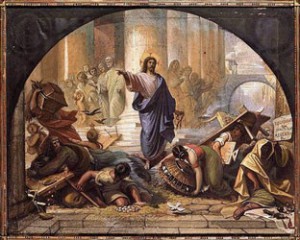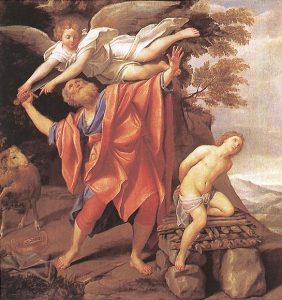 R.G. Price has posted an article expanding on his argument he made in Deciphering the Gospels that the “cleansing the Temple” scene is derived from an imaginative interpretation of a passage in Hosea and has no basis in any sort of historical memory of anything Jesus ever did. Price goes beyond the argument itself, however, and believes it is strong enough to serve as a lever against the standards of mainstream studies of the historical Jesus. He concludes:
R.G. Price has posted an article expanding on his argument he made in Deciphering the Gospels that the “cleansing the Temple” scene is derived from an imaginative interpretation of a passage in Hosea and has no basis in any sort of historical memory of anything Jesus ever did. Price goes beyond the argument itself, however, and believes it is strong enough to serve as a lever against the standards of mainstream studies of the historical Jesus. He concludes:
The relationship between the temple cleansing scene and Hosea 9 is real and it needs to be addressed by mainstream biblical scholars. It requires revising the models of mainstream scholarship and seriously reevaluating mainstream positions. The implications are vast and profound. The idea that it’s, “certain that Jesus did something that caused a disturbance in the Temple,” is no longer tenable. Anyone continuing to claim it is in light of this evidence should no longer be considered credible. Anyone who addresses the temple cleansing scene without addressing this literary dependency is either unaware of the most recent scholarship or intentionally ignoring it because they are unable to address it. From this point forward, addressing the temple cleansing without addressing its relationship to Hosea 9 is untenable.
That’s not how “mainstream biblical scholars” are going to respond, of course. Once they start with the “secure fact” that Jesus was crucified they need to find some grounds for that crucifixion that will not undermine whatever attributes he had that enabled his former followers to believe he was the messiah who had been raised to heaven. A misunderstood event in the temple serves that function. I think many of those scholars are well aware that the evangelists have culled words from the canonical Hebrew texts to colour the episode, but none of that seems to lead many to doubt the historicity of the event. The literary borrowings are said to reflect the deep meaning that the authors gave to the historical event that they are nonetheless sure must have happened.
Price has elaborated upon details in Hosea 9 that have surely inspired the three-fold steps of the gospel narrative:
- The idea of seeing fruit on a fig tree (Jesus approaches the fig tree looking for fruit)
- Driving sinners out of the temple (Jesus drives out the money-changers)
- The withering of the fig tree (the fig tree is found to be withered)
I think the case can be made even stronger by adding the other passages that our evangelist author has drawn upon. In addition to Hosea 9 we have Isaiah and Jeremiah:
Mark 11:15-17 (New King James Version)
15 So they came to Jerusalem. Then Jesus went into the temple and began to drive out those who bought and sold in the temple, and overturned the tables of the money changers and the seats of those who sold doves. 16 And He would not allow anyone to carry wares through the temple. 17 Then He taught, saying to them, “Is it not written, ‘My house shall be called a house of prayer for all nations’?[a]But you have made it a ‘den of thieves.’”[b]
Footnotes:
- Isaiah 56:7
- Jeremiah 7:11
(From BibleGateway.com)
Toss in Zechariah 14:21 for good measure:
No trader shall be seen in the house of the Lord.
In an earlier post I did point to the same passage in Hosea (along with other passages expressing the fig tree metaphor) but without Price’s elaboration of how it fits the structure of the episode in Mark:
The same theme of being planted to bear good fruit and being cursed and uprooted for bearing bad, and the lesson to be godly at all times, is repeated in Jeremiah 8.13; 32:36-41; Hosea 9:10-14.
Michael Turton also referenced the Hosea 9:10 passage in his commentary on Mark.
It is that last passage, Hosea 9:10-14 that Price teases apart and highlighting the chiastic structure of Hosea’s matching the chiastic structure of Mark’s “fig tree – temple – fig tree” unit.
We can go farther, yet. So far we can claim that each scene and each sentence in the narrative of the cursing of the fig tree and cleansing of the temple can be sourced to Scriptural sources. That’s fine, but there is also the literary function of the double episode itself in the framework of the gospel’s plot. (Again, refer to that “earlier post” above for details.)
For further literary linkages see Michael Turton’s commentary on Mark.
Everything about the episode has been constructed from well-known canonical passages and constructed for narrative plot. The author of the Gospel of John presented a Jesus quite different from the one found in the Synoptic gospels and replaced the temple cleansing scene with the raising of Lazarus. It was the raising of Lazarus that prompted the Jewish authorities to do away with Jesus. The fourth evangelist treated the temple action as a theological or symbolic action that he was free to move to the beginning of the gospel. Tim has shown the reason for this move in one of his posts: it served as a replacement for the synoptic Jesus being tempted in the wilderness.
It is as clear that the story is a composite literary artifice. The only grounds for concluding that it does have some historical core are a belief that Jesus was crucified even though he was a righteous and good man consumed with zeal for God and purity of worship. That the theme of the righteous man being unjustly executed by authorities and becoming an atonement for others is another literary-cum-theological trope in literature (Jewish and Greek) is something to be discussed another day.

